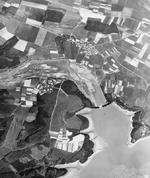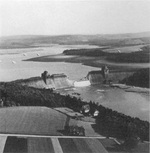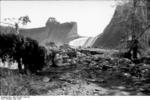Möhnesee Dam
| Type | 200 Other | |
| Historical Name of Location | Soest, Westfalen-Süd, Germany | |
| Coordinates | 51.489307000, 8.058772000 |
Contributor: Alan Chanter
ww2dbaseWith a length of sixty-nine kilometres the Möhne River rose near Brilon and joined the Ruhr River near Neheim in westerm Germany. At the turn of the 20th century the growing water needs of the German industrial areas resulted in the founding of the Ruhrtalsperrenvereins (RTV) at Essen in 1899. The RTV - or Ruhr Dam Association - decided that its three main aims should be; firstly, to decrease the damage caused by floods through the construction of Dams to store up, during the winter months of high precipitation, as much water as possible from the 430 square kilometres drainage areas of the Sauerland's higher regions. Secondly, to fully utilize the potential for hydro-electricity power stations, and finally, to feed water into the Ruhr River and its waterworks during the dry summer months.
ww2dbaseHaving established that the Möhne and Heve valley region provided the most favourable geological conditions for damming the river, work commenced in 1905 near the small town of Günne. The RTV had to acquire some 12 square kilometre of land in the Möhne valley for the reservoir which would stretch to a length of eleven kilometres in the Möhne valley and five kilometres in the smaller converging Heve valley. The widest part of the reservoir is 3 kilometres at the point where the two valleys meet and the total length of the reservoir's shoreline is 40 kilometres.
ww2dbaseBy the autumn of 1910 the majestic Möhne Dam had begun to take on its final shape. The artistic plans for this huge project were drawn by the Cologne architect Franz Brantzky (1871-1945) and the entire cost of the project, including the initial acquisition of the land, but excluding the power plants, was 24,560,000 Reich Marks. Standing at 40.30 metres above the floor of the valley, the Dam has a base length of 300 metres with a base thickness of 34.20 metres. The top has an overall length of 650 metres and the whole construction consists of 267,000 cubic metres of stonework. The Dam holds back 135 million cubic metres of water over an area of 3,229 acres. The average annual water flow through the Dam is 240 million cubic metres.
ww2dbaseApart from the dam, which cuts off the valleys of the Möhne and Heve to the west, several other major constructions were also found to be required. A bridge between the towns of Wamel and Völlinghausen on the north shore was erected at an early date. Another bridge, with a length of 650 metres (including the connecting causeways) built near Delecke had a height at the top of the arch of 28.65 metres. Additionally a bridge, 513.20 metres long, built at Korbecke was, at the time, Germany's longest stone bridge with a height of 22 metres above the valley floor. Furthermore, another dam 500 metres long, was built near Stockum with a smaller one in the Heve valley at the closure of a temporary regulating basin. Before the damming up of the Möhne reservoir could begin on 31 December 1912, over 700 people who lived in 200 dwellings in the Möhne valley had to be resettled.
ww2dbaseBeyond the dam wall was located the hydro-electric power station, which produced an annual output of 10 million kilowatt-hours. This was situated in the midst of garden layouts and surrounded by water. A smaller adjoining power station was built at the western flow-off of the adjustment pond. The overall direction of this vast project was vested in the government's master architect Ernst Link and on 12 July 1913, the official inauguration of the dam took place. Herr Link and his assistants Walter Raddatz and Walter Selbach, together with numerous honoured guests from Berlin and the Ruhr, would make a ceremonial trip around the newly flooded reservoir in four festively decorated motorboats belonging to the brothers Schmitz.
ww2dbaseFollowing World War I the Möhne reservoir and its surrounding woodlands became a popular excursion destination for a people needing recreational facilities after suffering from years of war and inflation. At the time that the artificial lake was being built, the Ruhr-Lippe Eisenbahn (railway) laid a miniature track as far as the dam which brought visitors from Soest, Werl, Hamm, Neheim and Arnsberg via Niederense to enjoy the facilities. During the course of a few years the banks of the reservoir, at Delecke, Korbecke, Wamel, and on the southern shore, saw much development to meet the demands of the numerous visitors. Outdoor swimming pools, a large youth hostel, sundry holiday homes and boat houses rapidly appeared. Rowing and sailing clubs were established, pathways built in the large woods on the south shore and the first benches were placed along the banks of the lake. The visitors who came to the Möhnesee enlivened the surrounding villages as well. The local inns enlarged their room facilities and created guest rooms. A former farm was converted into the luxury Hotel Haus Delecke on whose forecourt expensive automobiles owned by the industrial bosses from Dortmund, Essen and Duisberg were often to be seen. New hotels, cafes and pensions were added as the lake became ever more popular. So, in a short time, old and new hosts around the reservoir would earn a good income by adjusting themselves to their customer's varying demands.
ww2dbaseAs peaceful as it was, the Möhnesee could not, however, entirely escape the political events happening in Germany during the mid-thirties. Photographs of the time are known to have shown a tented camp for the Hitler Youth, and, in order that the German people might become a nation of flyers, a seaplane came to the reservoir in 1932 which, for approximately a week, made flights over the lake in order to arouse an interest in aviation by younger visitors.
ww2dbaseThe Dambusters
ww2dbaseThe Second World War saw the power and water supplied by the Möhne Dam become ever more important to feed Germany's expanding Ruhr armaments' factories. This did not go unnoticed to the Allies. At the Casablanca Conference US President Franklin Roosevelt and British Prime Minister Winston Churchill decided that one the Allies primary aims must be the destruction of the German armament industry in the Ruhr valley. During the early months of 1943, the fourth year of the European War, heavy night attacks by Allied bombers would cause severe damage to the industrial cities on the Ruhr and Rhine resulting in the German Air Defences having to be frequently transferred from one endangered point to another; thereby causing the effective 88-millimeter anti-aircraft guns to become ever more dispersed and scarce.
ww2dbaseThen in the summer of 1943, Air Chief Marshal Sir Arthur Harris (q.v.), Commander-in-Chief RAF Bomber Command, received a special instruction from the War Cabinet to disrupt the water supply to Ruhr industry by means of destroying the Möhne, Eder and Sorpe Dams. To achieve this aim the unique "Upkeep" bouncing bomb had been created by inventor Barnes Wallis (q.v.) which would be delivered by an elite force, called 617 Squadron, led by the highly decorated Wing Commander Guy Gibson. Equipped with specially modified four-engine Lancaster bombers, Gibson and his crews prepared for the mission utilising models of the reservoirs and with several training exercise flights where they practiced the release of the special bombs from just 18 metres above water level. These bombs would explode underwater much like a depth charge to add to their destructive effect. Meanwhile, Mosquito reconnaissance aircraft were secretly surveying the water capacity of the Möhne's reservoir and noting the German defences.
ww2dbase18 May 1943 was a Sunday which many local Germans planned to used for a recreational excursion to the Möhnesee. Shortly before midnight the sirens sounded throughout the region and the light anti-aircraft guns commenced firing against a number of low flying bombers approaching from the lake's end. Guy Gibson led the attack but his bomb was dropped too early. Flight Lieutenant J. V. "Hoppy" Hopgood was next to begin an attack but, when he was about 100 yards away, one of his inboard fuel tanks was hit by flak and set on fire. He dropped his mine but his bomb aimer must have been wounded because it fell straight onto the power-station on the far side of the Dam. "Hoppy" tried to gain a little height to allow his crew to bale out, but at 500 feet an explosion was witnessed; a wing fell off, and M-Mother fell to the ground in flames landing in a field some 3 miles beyond the dam.
ww2dbaseThe dam wall resisted near misses by the third and fourth bombs as well (Flight Lieutenants Harold "Mickey" Martin and Melvyn "Dinghy" Young). Finally Flight Lieutenant David Maltby DFC succeeded in releasing his bomb exactly in front of the wall between the dam's twin towers. It exploded about 15 metres beneath the water and, with a mighty crash the wall gave way allowing a tremendous torrent of water to cascade into the valley beyond. The remaining four aircraft in Gibson's group then flew on to successfully breach the Eder Dam.
ww2dbaseMillions of tons of stored water in two mighty torrents gushed down the Ruhr valley. The Möhne waters hit Niederense where a power-station was washed away. Surging on towards Neheim the flood carried away two bridges then engulfed Wickede, 15 miles from the dam. Here another bridge was demolished. Froendenburg was next invaded, then Schwerte. Twenty miles beyond Schwerte the Dahlhausen marshalling yards were inundated. Similarly the waters from the Eder Dam - the largest reservoir in Germany - escaping through a breach 180 feet wide descended on Bergheim, where it carried away a road bridge and destroyed a railway bridge over a length of 600 feet. The waters swept on to Fritzlar where they submerged a military aerodrome; reached and flooded Waburn; surging over wide areas between Waburn and Gensungen, then reached Kassel, 35 miles from the dam.
ww2dbaseThe flood waters then flowed into the Fulda valley causing a belt of desolation sixty miles long and many miles wide. At least 25 bridges had been destroyed, canal banks broken, roads and railway tracks badly damaged and coal mines flooded. Around 6,000 acres of farmland were stripped of their crops and 6,500 cattle and pigs killed. The damage and devastation caused to the German war industries in the Ruhr far exceeded that from any previous RAF raid and problems created by the flooding would shortly be magnified by a serious shortage of water. The lack of power and water in the Ruhr caused a loss of production to the war industries that was officially estimated to be the equivalent of 500,000 man-months of work.
ww2dbaseThe number of houses destroyed by the floodwater was 8 in Günne (with 12 apartments), 40 in Neheim (with 91 apartments), 1 in Bachum, 5 in Echthausen and 76 in Wickede. More or less badly damaged were approximately 200 further buildings. Official figures reported 30 dead in Günne, 8 in Himmelpforten-Niederense, 755 in Neheim, and 117 in Wickede. Amongst the dead, many of whom are unknown, were approximately 600 foreigners, mainly Russian female workers, but also holiday guests seeking rest. The victims included 53 RAF airmen too (three others became prisoners of war). The destruction of the former monastery estate Himmelpforten "Porta Coeli" near Niederense was especially regrettable. The Cistercian Order convent, confirmed by Pope Innocent IV in 1247, had reached great significance through the centuries but had become dilapidated by the eighteenth century and had been demolished in 1737 to be replaced with a new church built on the site of the former abbey. Here, Father Berkenkopf died in his church which had been the parish church for the community of Niederense-Himmelpforten since 1940.
ww2dbaseReconstruction
ww2dbaseFive days after the attack the reconstruction of the dam commenced. Over 2,000 workers, amongst them numerous specialists, were put to work, and by 22 October, the dam, including the upper covering of reinforced concrete had been largely repaired. The adjoining plants such as the power stations, the regulating basin and the broken bridges were left untouched, but the damming up of water in the reservoir could begin again after a summer with ample rain. The RAF did not bomb the repair work; nor did it repeat the use of the bouncing bomb – it was far too expensive in terms of crews lost. In fact the remaining stock of bouncing bombs would be dumped in the sea at the end of the war.
ww2dbaseIt was only at the beginning of the 1950s that the removal of the last of the war damage at the Möhne reservoir could be commenced. This included clearing up of the damage caused to the bridges on the southern shore which had been blown up by the retreating German forces. A new main power station with a yearly output of 15 million kilowatt–hours was erected at the side of the dam. The ruin of the old secondary power station was torn down and a new one erected at the western end of a larger regulating basin.
ww2dbaseIn November 1953 the regulating basin and the power stations were reinstalled, and in April 1955 a visitor was able to see once again water flowing over the dam. The water descends from a height of almost 40 metres through 105 vents each 2.50 metres wide into the regulating basin below as it did before the 1943 destruction.
ww2dbaseToday the Möhnesee remains a popular destination for excursions and outdoor activities with numerous places to dine and relax. For the hiker there are well laid out paths through the peaceful woods, while others may prefer a tour of the reservoir on a motorboat. From first class hotels to simple camping sites (plus the 230 bed Youth Hostel) the area provides year-long facilities for all visitors. On weekends and some fine excursion days the dam is floodlit at night making the construction look majestic against the dark night sky – its features reflected in the calm waters below. Barely a scar or even a scratch remains of the dam to remind a modern visitor of that fateful night in 1943 when terror and devastation had fallen upon it.
ww2dbaseSources:
Tourist Office Möhnesee: Dokumentation Erholungszentrum Möhnesee (Dülberg Publishing House)
Jarrod Cotter (Editor): Lancaster, Britain's Iconic War-Winning Bomber (Kelsea Media Publishing)
Guy Gibson: Enemy Coast Ahead (Goodall / Crécy Publishing - reprinted 2013)
Rupert Matthews: Heroes of Bomber Command–Lincolnshire (Countryside Books, 2005)
Professor David Edgerton: Britain's War Machine (Penguin Books 2011)
Everyman Encyclopaedia Volume 8
Last Major Update: Feb 2019
Möhnesee Dam Interactive Map
Photographs
 |  |  |  |
Möhnesee Dam Timeline
| 13 Dec 1912 | Damming work at the Möhne reservoir in Germany began. |
| 12 Jul 1913 | The official inauguration of the dam at the Möhne reservoir in Germany took place. |
| 17 May 1943 | The Möhnesee Dam in western Germany was breached by a British air attack. |
| 22 Oct 1943 | The dam at the Möhnesee reservoir in western Germany was largely repaired. |
Please consider supporting us on Patreon. Even $1 per month will go a long way! Thank you. Please help us spread the word: Stay updated with WW2DB: |

Soest, Westfalen-Süd, Germany
Latitude-Longitude:
51.4893, 8.0588
- » 1,181 biographies
- » 337 events
- » 45,111 timeline entries
- » 1,247 ships
- » 350 aircraft models
- » 207 vehicle models
- » 376 weapon models
- » 123 historical documents
- » 261 facilities
- » 470 book reviews
- » 28,471 photos
- » 365 maps
Joachim von Ribbentrop, German Foreign Minister, Aug 1939
Please consider supporting us on Patreon. Even $1 a month will go a long way. Thank you!
Or, please support us by purchasing some WW2DB merchandise at TeeSpring, Thank you!